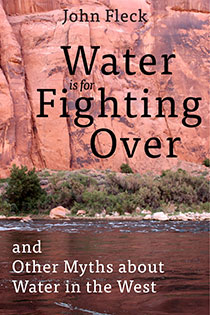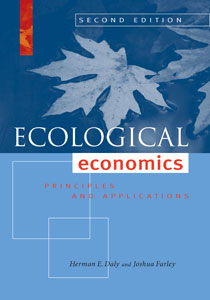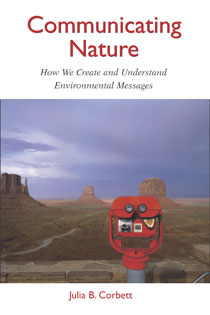This holiday season, give the gift of an Island Press book. With a catalog of more than 1,000 books, we guarantee there's something for everyone on your shopping list. Check out our list of staff selections, and share your own ideas in the comments below.
For the OUTDOORSPERSON in your life:

Water is for Fighting Over...and Other Myths about Water in the West by John Fleck
Anyone who has ever rafted down the Colorado, spent a starlit night on its banks, or even drank from a faucet in the western US needs Water is for Fighting Over. Longtime journalist John Fleck will give the outdoors lover in your life a new appreciation for this amazing river and the people who work to conserve it. This book is a gift of hope for the New Year.

Satellites in the High Country: Searching for the Wild in the Age of Man by Jason Mark
Do you constantly find your friend waxing poetic about their camping tales and their intimate connection to the peaceful, yet mysterious powers of nature? Sounds like they will relate to Jason Mark’s tales of his expeditions across a multitude of American landscapes, as told in Satellites in the High Country. More than a collection of stories, this narrative demonstrates the power of nature’s wildness and explores what the concept of wild has come to mean in this Human Age.

What Should a Clever Moose Eat?: Natural History, Ecology, and the North Woods by John Pastor
Is the outdoorsperson in your life all dressed up in boots, parka, and backpack with nowhere to go? Looking for meaning in another titanium French press coffeemaker for the camp stove? What Should a Clever Moose Eat leaves the technogadgets behind and reminds us that all we really need to bring to the woods when we venture out is a curious mind and the ability to ask a good question about the natural world around us. Such as, why do leaves die? What do pine cones have to do with the shape of a bird’s beak? And, how are blowflies important to skunk cabbage? A few quality hours among its pages will equip your outdoor enthusiast to venture forth and view nature with new appreciation, whether in the North Woods with ecologist John Pastor or a natural ecosystem closer to home.
Also consider: River Notes by Wade Davis, Naturalist by E.O. Wilson
For the CLIMATE DENIER in your life:

Cartoon Introduction to Climate Change by Yoram Bauman
This holiday season, give your favorite climate-denier a passive aggressive “wink-wink, nudge-nudge” with The Cartoon Introduction to Climate Change featuring self –described Stand-up Economist Yoram Bauman and award-winning illustrator Grady Klein. Give the gift of fun, entertaining basic understanding of what is, undeniably and not up for subjective debate, scientific fact!
Also consider: Heatstroke by Anthony Barnosky, Straight Up by Joseph Romm
For the HEALTH NUT in your life:

Unnatural Selection: How We Are Changing Life, Gene by Gene by Emily Monosson
Give the health nut in your life the gift of understanding with Unnatural Selection. Your friends and family will discover how chemicals are changing life on earth and how we can protect it. Plus, they’ll read fascinating stories about the search for a universal vaccine, the attack of relentless bedbugs, and a miracle cancer drug that saved a young father’s life.
Also consider: Toms River by Dan Fagin, Roads Were Not Built for Cars by Carlton Reid,
For the ADVOCATE in your life:

Prospects for Resilience: Insights from New York City's Jamaica Bay by Sanderson, et. al
Need an antidote to the doom and gloom? Stressed-out environmental advocates will appreciate Prospects for Resilience: Insights from New York City's Jamaica Bay. It’s a deep dive into one of the most important questions of our time: how can we create cities where people and nature thrive together? Prospects for Resilience showcases successful efforts to restore New York’s much abused Jamaica Bay, but its lessons apply to any communities seeking to become more resilient in a turbulent world.

Ecological Economics by Josh Farley and Herman Daly
Blow the mind of the advocate in your life with a copy of Ecological Economics by the godfather of ecological economics, Herman Daly, and Josh Farley. In plain, and sometimes humorous English, they’ll come to understand how our current economic system does not play by the same laws that govern nearly every other system known to humankind—that is, the laws of thermodynamics. Given recent financial and political events, there’s a message of hope within the book as it lays out specific policy and social change frameworks.
Also consider: Tactical Urbanism by Mike Lydon, Cooler Smarter by The Union of Concerned Scientists
For the CRAZY CAT PERSON in your life:

An Indomitable Beast: The Remarkable Journey of the Jaguar by Alan Rabinowitz
The cat lovers in your life will lose themselves in An Indomitable Beast, an illuminating story about the journey of the jaguar. This is the perfect book for any of your feline loving friends, whether they want to pursue adventure with the big cats of the wild, or stay home with a book and cup of tea.
Also consider: The Carnivore Way by Cristina Eisenberg, Jaguar by Alan Rabinowitz
For the GARDENER in your life:

Wild by Design: Strategies for Creating Life-Enhancing Landscapes by Margie Ruddick
Give your favorite gardener an antidote to the winter blues. The lush photographs of Wild by Design, and inspirational advice on cultivating landscapes in tune with nature, transport readers to spectacular parks, gardens, and far-flung forests. This book is guaranteed to be well-thumbed and underlined by the time spring planting season arrives!
Also consider: Brilliant Green by Stefano Mancuso, Principles of Ecological Landscape Design, Travis Beck
For the STUBBORN RELATIVE in your life:

Common Ground on Hostile Turf: Stories from an Environmental Mediator by Lucy Moore
For the person keeping the peace in your family this holiday season, the perfect gift is Common Ground on Hostile Turf, an inspiring how to guide demonstrating it is possible to bring vastly different views together. This book gives lessons learned on setting down at the table with the most diverse set of players and the journey they take to find common grounds and results. If your holiday dinner needs some mediation, look to the advice of author Lucy Moore.
Also consider: Communication Skills for Conservation Professionals by Susan Jacobson, Communicating Nature by Julia Corbett
For the HISTORY BUFF in your life:

The Past and Future City: How Historic Preservation is Reviving America's Communities by Stephanie Meeks with Kevin C. Murphy
When it comes to the the future of our cities, the secret to urban revival lies in our past. Tickle the fancy of your favorite history buff by sharing The Past and Future City, which takes readers on a journey through our country's historic spaces to explain why preservation is important for all communities. With passion and expert insight, this book shows how historic spaces explain our past and serve as the foundation of our future.
Also consider: The Forgotten Founders by Stewart Udall, Aldo Leopold's Odyssey, Tenth Anniversary Edition by Julianne Lutz Warren
For the BUSINESS PERSON in your life:

Nature's Fortune: How Business and Society Thrive by Investing in Nature by Mark Tercek
For the aspiring CEO in your life who drools at phrases like "rates of return" and "investment," share the gift of Nature's Fortune, an essential guide to the world's economic (and environmental) well-being.
Also consider: Corporation 2020 by Pavan Sukhdev, Resilient by Design by Joseph Fiksel

